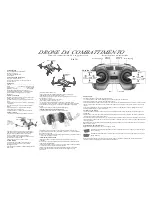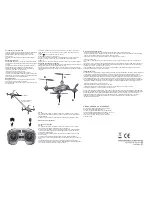
Land Your Drone
Replace Damaged Propellers
Drone difficult to control
FCC Information
Troubleshooting
Drone does not respond
Perform Stunts
Dogfight!
1.Slowly move the throttle backward to descend. Avoid
1.Use the throttle and steering controls to fly and hover close. When
within 16 ft of youroffonent,level to fire.
•
Press and hold for a rapid volley, or
•Press to shoot single fire.
2.When your drone is hit, the LEDs blink and the drone shakes and spins.
•After receiving a third hit, the casualty drone will automatically s
lowly
descend and land.
3.Never give up. Move throttle forward to take off for another baaale!
•
The throttle control is very sensitive. Use small, fine movements to control.
•
Propellers maybe bent. Adjust propellers by hand. If you cannot adjust them, replace with the spare propellers.
•
Practice in low speed mode. See “Fly Your Drone."
•The gyroscope inside your drone may need calibrating:
Calibrate Your Drone
1.With your drone and remote control switched on and paired, place the drone on level ground.
2.Move the throttle all the way down.
3.Move the steering forward and hold this position for a few seconds until the drone LEDs start to blink.
4.Release the steering. The drone LEDs light steadily, indicating successful calibration. You are now ready for
takeoff.
•See “Trim Your Drone" to fine tune hovering and movement to further improve control of your drone after
calibration.
This equipment has been tested and found to comply with the limits for a Class B digital device, pursuant to
Part 15 of the FCC Rules. These limits are designed to provide reasonable protection against harmful
interference in a residential installation. This equipment generates, uses, and can radiate radio frequency
energy and, if not installed and used in accordance with the instructions, may cause harmful interference to
radio communications. However, there is no guarantee that interference will not occur in a particular
installation. If this equipment does cause harmful interference to radio or television reception, which can be
determined by turning the equipment off and on,the user is encouraged to try to correct the interference by
one or more of the following measures:
•Reorient or relocate the receiving antenna.
•Increase the separation between the equipment and receiver.
•Connect the equipment into an outlet on a circuit different from that to which the receiver is connected.
•Consult the dealer or an experienced radio/TV technician for help.
If you cannot eliminate the interference, the FCC requires that you stop using your equipment. Changes or
modifications not expressly appro
ved by the party responsible for compliance could void the user’s authority
to operate the equipment. This device complies with Part 15 of the FCC Rules. Operation is subject to the
following two conditions: (1) this device may not cause harmful interference, and (2) this device must accept
any interference received, including interference that may cause undesired operation.
The left and right propellers marked A/B on the propeller. of the
drone
are different, and You must use the correct propeller in the correct
location.
To replace a damaged propeller, remove the old one and press the new
one onto the propeller axle. If you cannot remove the old propel
ler by
hand, use pliers.
WARNING:
•
To avoid injury and damage, check the propellers for nicks and breaks
and make sure they are securely attached before and after each flight.
Replace any damaged propellers.
•Use only the supplied propellers. Do not alter, modify, orcustom
ize the
propellers.
WARNING:
•
Make sure the drone and remote control are switched on and paired.
•Avoid pairing both drones at the same time within 10 feet as thi
s causes
interference. Pair each drone with its matching remote control
individually.
•Drone battery maybe low. Fully charge the battery. See “Charg
e the
Drone.“
•Remote control batteries maybe low. Replace the batteries.
•Make sure the drone is within the control range (65 ft) and in lin
e of
sight.
•In battle mode, make sure you fly within IR range (16 ft), and lev
el with
your opponent to shoot. Stage your battles indoors to avoid strong
sunlight which affects IR reception.
moving the throttle too quickly, as it can stop the
propellers instantly and cause the drone to crash.
2.When you finish playing, turn off the remote control
and drone.
CAUTION: Make sure there is enough space for the
drone to perform stunts without crashing into objects
or people.
1.Push the throttle control to activate stunt mode. The
remote control beeps repeatedly.
2.Use the steering control to perform stunts:
•Front flip:Move steering forward
•Back flip:Move steering backward
•Barrel roll: Move steering right or left
3.The drone automatically exits stunt mode after
performing a stunt, or push in the throttle control
again to exit immediately.
Battle with a friend. You will to shoot deadly infrared
need to fly within close range missiles.
Each player has 3 lives per challenge. First drone to lose
all 3 lives goes down!
IR sensor
Maximum
distance 16 ft (5m)
B
B
A
A
EU-DECLARATION OF CONFORMITY
Hereby, Oregon Scientific, declares that Drone Fighter
with internet radio (model: TG513) is in compliance
with the essential requirements and other relevant provisions
of Directive 2014/53/EU. A copy of the signed and dated
Declaration of Conformity is available on request via our Oregon
Scientific Customer Service.





















